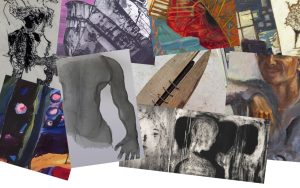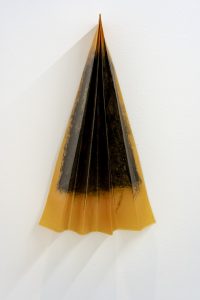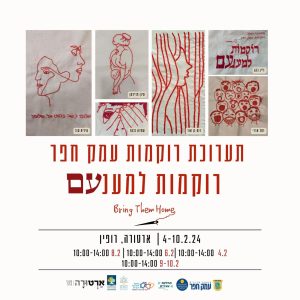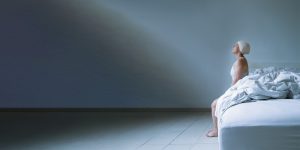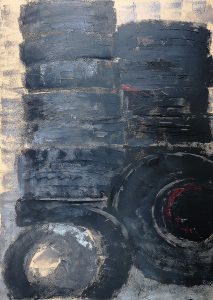
Plating the Field
Illustrations & Chefs’ Creations
Curator: Yifat-Sarah Pearl
The exhibition “Plating the Field” presents illustrations and Drawings of recipes from the sketch notebooks of Israel chefs, who visually document their new dishes and thereby reveal their mutual relations with the food – its source, appearance and means of preparation. Most of us in the modern world have disconnected from the processes of creating food and thus are also unaware of the source of our food, of the raw ingredients that comprise it, its origin and its ‘adventures’ on the journey to the table. This disconnection and alienation between ourselves and our food began during the Industrial Revolution and the conversion of food into industrialised food and, finally, into the processed food of today whose nutritional value and personal connection with us are lacking.
The list of illustrations presented at the exhibition are not artistic creations in the classical definition. Nonetheless, they reflect a fascinating and unique visual documentation by the chefs, expressing the notion of creating a meal on a plate. The exhibition offers a detailed documentation of experimenting with raw materials and methods in the kitchens, which assists the chefs to create a dialogue relating to their work methods and the new technologies adopted in order to create a new dish. This – their notebook – is their tool for developing and refining a language of food that expresses how the chef becomes a creator and planner of an architectonic space: the plate. In this space the different raw materials come together, fruit and vegetables, fish and meat, incorporating different techniques. The act of cooking is preserved, documented and created through the analysis of methods and theories that help to interconnect with the vast richness of the world of cooking and of culinary history.
Familiarity with the field, the growers, the farmers, the agricultural area and the seasonality of growth are the connections that the chef Erez Komarovsky seeks to express in his site-specific presentation, called “Field Brigade”. This is a field of Arab lettuce planted at the appropriate time (sponsored by the “Aleh Aleh” company in Emek Hefer) in the backyard of the gallery. Komarovsky presents 22 scarecrows as images of cooks that he locates outside, in nature, unlike their natural place indoors, in the kitchen. In this way he asks them to disconnect from the “stardust”, go out into the field, talk with the farmer and the land, experience nature. The scarecrows symbolise the person who knows the land, who does not struggle against the raw materials and knows how to prepare a good and unmanipulated lettuce salad. The Arab lettuce symbolises familiarity with the natural resources of our land, the acceptance of differences, of humanity in our society – and, in the present era of concern for the rights of all humankind, the scarecrows gather together in the backyard, in the field, and are silent together.
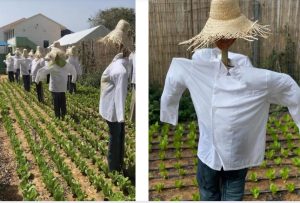
The French naturalist Jean Henri Fabre related to the enduring lettuce in a socio-political study of food and misunderstanding of the connections, and wrote: “ “History celebrates the battlefields whereon we meet our death, but scorns to speak of the plowed fields whereby we thrive. It knows the names of the king’s bastards but cannot tell us the origin of wheat. This is the way of human folly.” (from Prof. Nimrod Loz’s book, Lunch breaking, 2022).
The demand, the cooking, the eating, the spending of time – all these are linked to responsibility, and the responsibility involves learning. The chefs who imagine their dish by means of illustrations and Drawings, also reveal their relation to food and how they create it – Gil Dahan, Shirel Berger, Ariella Azran, Joseph Korson and Oscar Zuckerman; and the recipe developers – Danya Weiner and Batia & Amir Nizan, convey culinary, ideological and educational messages that stimulate the dialogue on food, and their mutual relations with the farmer who mediates between the dream and the creation of a new dish from the field.
We wish specially to thank all the chefs who collaborated on this project, who gave of their time and expanded our horizons through their fascinating notebooks. We thank also the “Aleh Aleh” company; Gideon Bilinsky for the fruitful dialogue on the findings of the exhibition, and Ofra Barak and Keren Krap of the Gallery staff, for their generosity and professional guidance.
· The verb ‘Tslichut’ (plating) derives from the noun ‘Tsalachat’ (plate), and in standard Hebrew it means ‘plate arrangement’, ‘plate design’ (The Academy of the Hebrew Language)
:Exhibition Participants
Gil Dahan, Chef (formerly of the Weiss Restaurant, Tel Aviv)

Illustrations from a sketch notebook, pencil and black pen (2019-2023)
The illustrations, as a visual dimension of the culinary worldview of Chef Gil Dahan, reveal his thought processes regarding the raw materials involved in creating a new dish. The illustrations are hung on the kitchen wall of the restaurant and serve to help the team of workers to understand the work process that faces them. The team thereby gains familiarity with the different ingredients and new culinary techniques, as well as ideological and educational messages, such as maximum exploitation of the raw material and great attention to avoiding the waste of food.
Ariella Azran, Chef (Tel Aviv)
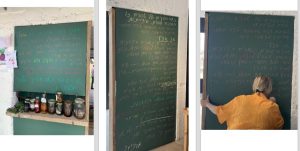
Sketches, chalkboard, coloured chalk (2023)
Azran has an emotional relationship with the vegetables on her table. On the walls of her house she writes up her feelings about the raw materials picked in the field and brought to her directly from the farmer, as a source of emotional support for creating her dishes. For her, the way to preparing the food lies in knowing the way that the fresh produce took from the field, up to the moment that it reached her. The traces on her wall clearly reveal that her gastronomic work is based on the understanding that familiarity and appreciation of the abundance that the field provides us, lead to a more correct and enriching connection with the food that finds its way to our table.
Shirel Berger, Head Chef and Owner of the OPA Restaurant (Tel Aviv)
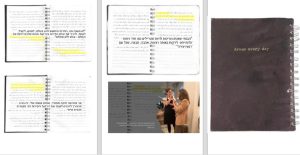
Sketches, personal handwritten diaries, coloured pens (2018-2022)
Berger presents her personal diaries as a visual expression of her thoughts and as an emotional outlet in her relationship with the fruit and vegetables, in a personal dialogue with herself. Among the desires and dreams, and expression of her love life, she interweaves in her diary, “Dream every day”, messages directed at the world, on our relationship with nature, with Mother Earth. The quotations from her diary explain to us the need for familiarity with the raw material and with the process of creating from it. The deeper we enter the study of food, the more we encounter the many complexities and dilemmas that arise – from the destruction of the environment that accompanies the growing, preparation and transport of food, to the increasing reliance on processed food, food waste, worker exploitation, and more.
Amir & Batia Nizan (Tel Aviv)
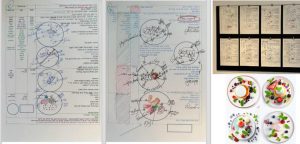
Illustrations on the back of printed menus, coloured pens (2017-2023)
The Nizan couple cook festive and family meals accompanied by a worksheet describing the order of the dishes, the different components and a sketch of the plated dish. The documentation assists them to maintain variety and to ensure that the dishes do not repeat themselves. Throughout the years the changes they have been forced to make following different constraints can be seen: various allergies, changes in agricultural produce, the disappearance of some raw materials and the appearance of others. Through these sketches they examine the components and develop the basis for a common language, to work together in the kitchen. The recipes express the very personal journey they have taken, and their arrival following a long process of gathering data and acquiring extensive culinary knowledge.
As part of the organisation of the current exhibition, an attempt was made to trace the dishes on the menu by means of an AI application (Midjourney). The resulting computerised simulations raise the question of whether, by means of such applications, it is possible to create new techniques and concepts that will enable the invention and practice of many new recipes. Together with these, new ethical questions arose, such as to whom, exactly, do they belong? Can ‘copyright’ even be claimed for creating such dishes?
Joseph Korson, Chef (Jerusalem, formerly chef to the Prime Minister)
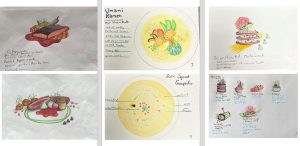
Illustrations, watercolours and Panda crayons (2022-2023)
Korson uses illustrations as a tool in the process of creating the kitchen and as an expression of thinking and ideas. His illustrations contain messages and hints regarding the culinary heritage from which he imbibed, and of the various cultures that come together to constitute the immense richness of the world of cooking. The connection between past and future, between the roots and the traditional dishes, in designing gourmet, contemporary, food, connects the diners with their identify and culture. Items such as falafel, malawach and eggplant create memories of taste for Korson and the desire to preserve these cooking traditions from the past as part of our cultural heritage. The creation is eaten and not everlasting, but is inscribed in our memories. Korson connects to an identity and to roots while preparing his sophisticated dishes, usually served at diplomatic events.
Oscar Zuckerman, Chef (Jerusalem, born in Romania)
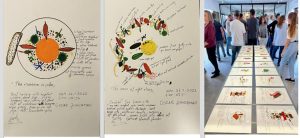
Sketches and illustrations, coloured marker pens (2019-2022)
By means of illustrations, Oscar engineers his future dish in minute and highly accurate detail, sketching and incorporating the elements, the components, from which he will create the dish. He devotes much attention to the materials that have undergone various processes – chopping, folding, colouring, heating; and even to processes belonging to molecular gastronomy, such as the physical and chemical processes that help to develop new techniques for the preparation of food. Zuckerman introduces a solid knowledge of culinary techniques, plating skills and visual appeal. The illustrations capture the different methods he employs in creating a new dish, enabling him to establish a dialogue among chefs and to examine the different flavours, colours and textures of each new dish.
Danya Weiner, Recipe Developer and Illustrator (Pardess Hanna)
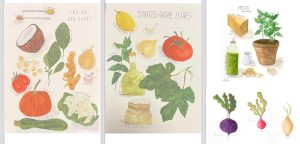
Illustrations, acrylics (2022-2023)
The recipe and raw material illustrations add an extra dimension to mediating between the consumers and the field. Weiner photographs prepared dishes in order to awaken the appetite, and she is currently developing recipes and illustrating them in order to awaken the need to cook. The illustrations demonstrate the substantiality of the colours and textures of the fresh raw ingredients, the vibrant colours of the vegetables that arrive directly from the field. She illustrates them as portraits, with great attention to their shape and other details. These recipe illustrations serve as a tool to invisibly discern between processed material, and fresh raw material straight from the field.
תערוכות נוספות שיכולות לעניין אותך
רוצים להשאר מעודכנים בתערוכות הבאות?
מלאו פרטים ותשארו מעודכנים בסדנאות הקרובות במרכז ארטורה

